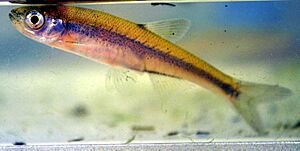Bigeye shiner facts for kids
Quick facts for kids Bigeye shiner |
|
|---|---|
 |
|
| Juvenile | |
| Conservation status | |
| Scientific classification |
The bigeye shiner (Notropis boops) is a small, shiny fish that lives in rivers and streams. It's a type of minnow with a slender, silvery body and a dark stripe along its side. This fish can grow up to about 3 inches (80 mm) long. Its most special feature is its really big eyes!
Bigeye shiners love warm, calm parts of streams with clear water. They prefer places with clean, sandy or rocky bottoms, free from mud. Unfortunately, things like mud in the water, changing river paths, and digging up gravel can harm bigeye shiner populations. These fish lay their eggs in batches, usually from late April to August. Groups like state agencies and the EPA help keep an eye on how many bigeye shiners there are. Sadly, their numbers have gone down in some places, like Ohio, mostly because their homes are being destroyed.
Contents
Where Do Bigeye Shiners Live?
The bigeye shiner is a common fish in streams across the middle Mississippi River system. You can find them in places like Kentucky, Tennessee, northern Alabama, and parts of Missouri, Arkansas, Oklahoma, Louisiana, and Kansas.
In Ohio, a lot of mud in stream bottoms and cloudy water from farming have caused problems. This has hurt or even wiped out some bigeye shiner groups. Large dams can also split up fish populations. This makes it hard for them to survive because their habitat becomes too small. Dams can also change water temperature, flow, and oxygen levels, which are bad for the fish. All these changes to their homes are making it harder for Notropis boops to thrive in many waterways.
What Is the Bigeye Shiner's Habitat Like?
Bigeye shiners live in flowing, usually clear, and rocky pools of creeks and small to medium-sized rivers. The bottom of their habitat is often made of gravel, rock, or sand. You can often spot them near plants growing along the edge of the stream.
They prefer streams with a good flow because the water helps carry mud out of the pools. This keeps their homes clean. Bigeye shiners live and feed both near the bottom and closer to the surface of the river.
What Do Bigeye Shiners Eat?
The bigeye shiner uses its excellent eyesight to find food. They mostly eat small insects that hover near the water's surface. They also munch on tiny creatures that live in the water. Because they rely on their sight, clear water is super important for them. Cloudy water and mud are big threats to their ability to find food and survive.
How Do Bigeye Shiners Reproduce?
Most bigeye shiners lay eggs during their second summer of life. Only a few live long enough to lay eggs the next year. They lay more than one batch of eggs each season.
When bigeye shiners lay their eggs depends on a few things. Water temperature and rainfall are the main factors that affect their breeding cycles. In Kansas and Missouri, they usually lay eggs from June into August. In southern areas, some males with breeding bumps (called nuptial tubercles) and females with ready eggs have been found from April to August. More mud in the water from farm runoff or new dams can make it harder for them to successfully reproduce.
How Are Bigeye Shiners Protected?
Right now, not much special management is happening for the bigeye shiner. According to the IUCN Red List of Threatened Species, this fish is not considered to be in serious danger. This means it doesn't need a lot of extra protection, monitoring, or research at the moment.


